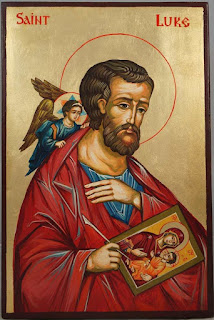Three reflections for Good Friday
Three reflections for Good Friday
- These reflections are based on St John's Passion Gospel. I have not published here due to considerations of length, but also because it will be used at part of the Good Friday liturgy.
and we bless you.
By your holy Cross
you have redeemed the world.
- These reflections are based on St John's Passion Gospel. I have not published here due to considerations of length, but also because it will be used at part of the Good Friday liturgy.
Ecce
Homo:
Pilayte said to the crowd 'Behold the man'
This
statue by the sculptor Mark Wallinger stood on the fourth plinth of Trafalgar Square.
It is a reminder of how public, and how lonely the whole process of the trial before Pilate and the crucifixion actually was. In this image Jesus stands as though at edge of the precipice, but he also stands
with confidence looking out to the crowds below even as they condemn him. This statue begs of us the
question of who is beholding whom? Are we looking at Jesus, or is he looking at us? And what does his look contain? Condemnation or pity?
Reflection: In this
moment are we beholding the condemned Jesus, or is he looking at us? And if it
is him looking at us, what would he say to us?
The Crucifixion
‘Let his blood be upon is and our
Children’. (Matthew 27.25)
Marc Chagall is a
controversial figure in the world of art and faith. An Orthodox Jew who paints images of the Crucifixion. Similarly, these words of Christ are controversial and open to disastrous misinterpretation, as we shall see below.
This painting by Chagall, The White Crucifixion, is a reminder of how the death of Christ
has been misused as a means to justify the persecution of the Jews, whether in
Russia (the painting depicts the pogroms that took place against Jewish people
and communities in Tsarist Russia), mid-twentieth century Germany, medieval Lincoln
and York, or in our own time. It is also
a reminder that Christ lived and died as a Jewish rabbi, not as a Christian! (Chagall himself was the victim of anti-Semitism at various stages of his li fe, from the Pogroms of Tsarist and Communist Russia in his early life onward.) When we consider these points we should also remember that the early Church was
mainly Jewish and understood itself as such, and when Saul (later St Paul) persecutes the early Church, it was
akin a family argument, rather than a fight between two different faith groups.
The truth is that Christ dies
for sinful humanity, and we are each and every one of us participants in the condemnation of Christ and his crucifixion, and as we hear the story of Christ's Passion we hear our own voices (in the words of the song writer Stuart Townsend) ‘call out
amongst the scoffers’! And if this is true, then the blood of Christ is
also upon each and every one of us, but not as a condemnation, but as redemption, a saving grace.
Reflection: Take a
moment to remember before God his first chosen, the Jewish people. Ask his
forgiveness for the ways in which Christians have abused the Jewish people, and
so often used the words of sacred scripture against them. Remember that we are
of the same family, and that Jesus and the disciples were not Christians in
embryo, but Jewish men.
Christ the King
‘Forbid it Lord,
that I should boast, save in the death of Christ my God’.
The cross is not
just an instrument of torture and execution, it is also an image of victory, the
moment when sin, death and hell are finally defeated. It is a throne, on which
the King of Glory is enthroned, his head crowned with a thorns.
Reflection: Take a
moment to pray these words:
We adore you O Christ, and we bless you.
By your holy Cross
you have redeemed the world.





Comments
Post a Comment